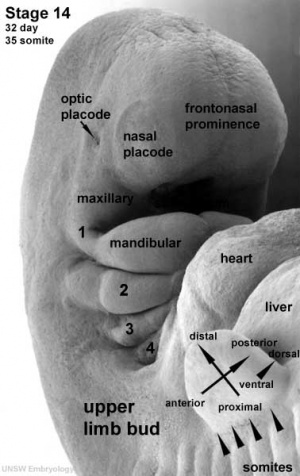2009 Lab 9: Difference between revisions
No edit summary |
|||
| Line 2: | Line 2: | ||
[[File:Stage14 sem2b-limb.jpg|thumb|Human Embryo stage 14 sensory placodes]] | [[File:Stage14 sem2b-limb.jpg|thumb|Human Embryo stage 14 sensory placodes]] | ||
== Introduction == | == Introduction == | ||
This laboratory | This laboratory is a introduction to development of senses (sight, smell, hearing and balance) through the development of the specialized sense organs (eye, nose and ear). Portions of the eye, nose and ear appear very early in development as specialized surface regions (placodes) on the embryo, these regions must be connected to the central nervous system by neural pathways that originate as extensions of the central nervous system. | ||
The laboratory will also allow time for work on the group online project. | The laboratory will also allow time for work on the group online project. | ||
Also with the reorganization of the timetable, if we have time I will briefly review the integumentary system. | |||
==Objectives== | ==Objectives== | ||
Revision as of 12:42, 1 October 2009
Sensory Development
Introduction
This laboratory is a introduction to development of senses (sight, smell, hearing and balance) through the development of the specialized sense organs (eye, nose and ear). Portions of the eye, nose and ear appear very early in development as specialized surface regions (placodes) on the embryo, these regions must be connected to the central nervous system by neural pathways that originate as extensions of the central nervous system.
The laboratory will also allow time for work on the group online project.
Also with the reorganization of the timetable, if we have time I will briefly review the integumentary system.
Objectives
- Understand development of the sensory systems.
Group Online Project
- Second part of Laboratory, do not work on this in first half.
- Each group project should now have individual peer assessment feedback added to the discussion page.
- No assessment or signature on your comment - no marks! All individual assessments need to be signed in order to get your mark for this component.
- I will explain how as a group to respond to the assessment comments, before final submission for co-ordinator assessment.
UNSW Embryology Links
Glossary Links
- Glossary: A | B | C | D | E | F | G | H | I | J | K | L | M | N | O | P | Q | R | S | T | U | V | W | X | Y | Z | Numbers | Symbols | Term Link
Course Content 2009
Embryology Introduction | Cell Division/Fertilization | Cell Division/Fertilization | Week 1&2 Development | Week 3 Development | Lab 2 | Mesoderm Development | Ectoderm, Early Neural, Neural Crest | Lab 3 | Early Vascular Development | Placenta | Lab 4 | Endoderm, Early Gastrointestinal | Respiratory Development | Lab 5 | Head Development | Neural Crest Development | Lab 6 | Musculoskeletal Development | Limb Development | Lab 7 | Kidney | Genital | Lab 8 | Sensory - Ear | Integumentary | Lab 9 | Sensory - Eye | Endocrine | Lab 10 | Late Vascular Development | Fetal | Lab 11 | Birth, Postnatal | Revision | Lab 12 | Lecture Audio | Course Timetable
Cite this page: Hill, M.A. (2024, April 30) Embryology 2009 Lab 9. Retrieved from https://embryology.med.unsw.edu.au/embryology/index.php/2009_Lab_9
- © Dr Mark Hill 2024, UNSW Embryology ISBN: 978 0 7334 2609 4 - UNSW CRICOS Provider Code No. 00098G
